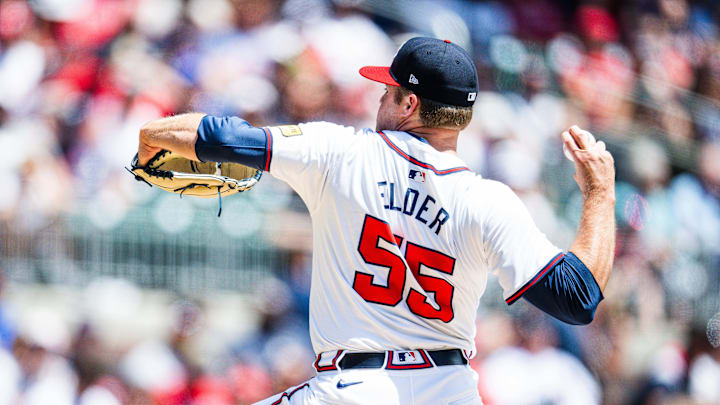Bryce Elder has made two solid starts for the Atlanta Braves this season. After two starts, Elder has posted a 1.50 ERA over 12 innings pitched. Elder's 89.8 mph fastball velocity ranks among the slowest in the league in the fifth percentile according to Baseball Savant. Elder's primary fastball is his sub-90 mph sinker. He ranked in the sixth percentile last season. He'll tell you he's not worried about his velocity, but a few things have to change if he's going to be an affective pitcher at this velo.
Bryce Elder has to pitch to contact
Elder's chase rate is in the 11th percentile and his whiff rate is in the 23rd percentile. We know that Elder is not a "stuff" guy. He doesn't strike many people out as evidenced by his 12.2% K-rate (3rd percentile). If a pitcher is pitching to contact then you hope to see a lot more soft contact than hard. That just hasn't been the case with Bryce.
Bryce Elder gives up a lot of hard contact
Nearly half of Elder's balls in play have been of the hard-hit variety. So, he's been pitching to contact this season effectively... it's just really hard contact. Of Elder's 37 balls in play this season, 18 have been 95 mph or more.
You could say that Elder has worked his way out of some tough jams, which is always commendable. But this season could look a whole lot different if it were not for a few lucky breaks in a rough first inning of his debut.
Bryce Elder allowed three straight hits, including a double, to begin a scoreless first. The video will answer your question. pic.twitter.com/8i6w3lWiAf
— Mark Bowman (@mlbbowman) April 22, 2024
Bryce Elder has been getting a ton of groundballs
One of the reasons all of the hard-hit balls haven't translated into a ton of damage is Elder's insane groundball rate so far this season. He's always been really good at generating ground balls with a 50% rate in 2022 and a 50.6% in 2023. This year, he's frustrated opposing hitters to the tune of a 64.9% groundball rate.
That may not be sustainable, but it's one way to mitigate the damage on so many hard-hit balls. Elder's hard-hit rate is definitely on the high end of what we are accustomed to seeing, as well. Last year he finished with a 41% hard-hit rate, which was in the 37th percentile in the league. Again, not what you want to see from a soft-tossing, pitch-to-contact guy, but it was certainly better than what we've seen thus far.
Elder's walk rates + hard-hit rates are worrisome
Elder has potential, but with his profile, he needs to lower the walk rate (46th percentile last year and 52nd percentile this year) and keep the hard-hit balls to a minimum. Pitching to hard contact while being middle-of-the-pack in walk rates is not a recipe for success in Major League Baseball.
It's been a very small sample size and things could have gone much worse than they have. Overall, I think Braves fans have to be excited to see Elder fight through some tight situations to give the Braves two solid outings so far this season.
Is it okay to worry about Bryce Elder's underlying metrics?
Yes it is. Some people will say it's just negative talk, and to a degree it is me being negative. However, the same thing was said last season after his All-Star appearance and Elder did, in fact, regress to the mean. He went from one of the best-starting pitchers in all of baseball in the first half to one of the absolute worst in the second half.
Elder's next start is schedule for Saturday, May 4th in Los Angeles against the Dodgers. He's going to need to bring his A-game to hold the Dodgers at bay. We will all be rooting for Bryce to make a statement on Saturday.
